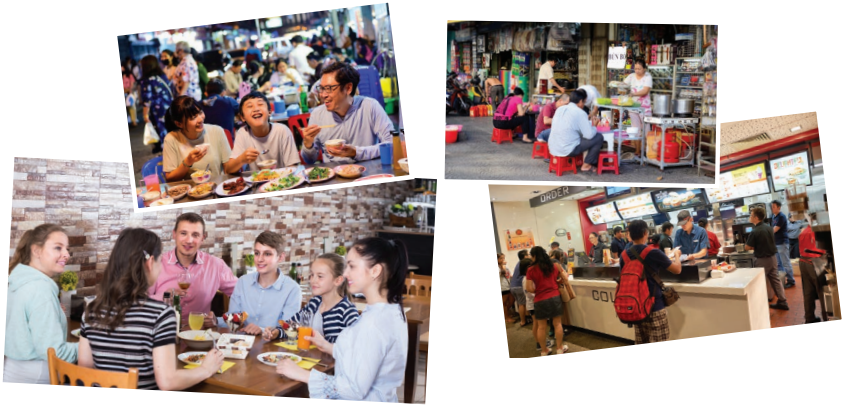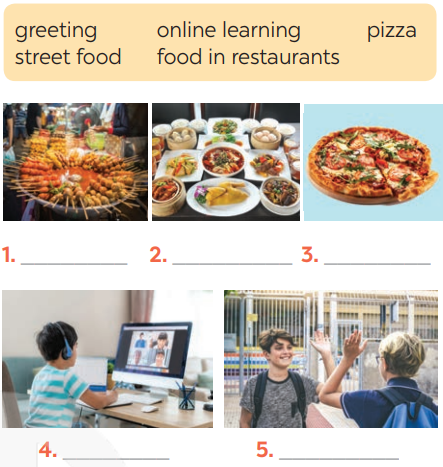Tiếng Anh 8 Unit 6 Getting Started1. Listen and read. 2. Read the conversation again and complete the table. 3. Complete each sentence with a word or phrase from the box. 4. Label each picture with a word or phrase from the box. 5. Greetings around the world. Take the quiz. Tổng hợp đề thi học kì 2 lớp 8 tất cả các môn - Kết nối tri thức Toán - Văn - Anh - Khoa học tự nhiên
Lựa chọn câu để xem lời giải nhanh hơn
Bài 1 Video hướng dẫn giải Lifestyle differences (Sự khác biệt về lối sống) 1. Listen and read. (Nghe và đọc.) Nam: Hello, Tom. How're things? Tom: Oh good. I like it here. The lifestyle is interesting and different from that in my country. Nam: Really? Tom: Sure. Students here call their teachers by their title "teacher", not by their names. Nam: Right. How do you greet your teachers? Tom: We usually say "Hello" or "Good morning" then Mr, Mrs, or Miss and their surnames, for example "Good morning, Mr Smith." Nam: Are there other differences? Tom: People buy and sell a lot of street food here. In my country, people usually buy food in a store or a restaurant. Nam: Yeah. Buying street food is a common practice in my city. Tom: And I've noticed that many people have breakfast on the street too! In my country, we typically have a light breakfast at home. Nam: I see. But here many adults are in the habit of having breakfast outside of their homes. If they're not in a hurry, they'll even have a leisurely coffee there. Tom: That's fascinating!
Phương pháp giải: Tạm dịch: Nam: Chào Tom. Mọi chuyện thế nào rồi? Tom: Ồ tốt mà. Mình thích ở đây. Lối sống ở đây rất thú vị và khác biệt với đất nước mình. Nam: Thật không? Tom: Học sinh ở đây chỉ gọi giáo viên của họ bằng chức danh “thầy hoặc cô” thôi, không gọi tên. Nam: Đúng rồi. Cậu chào giáo viên như thế nào? Tom: Tụi mình thường nói “Xin chào” hoặc “Chào buổi sáng” sau đó là thầy hoặc cô và họ của người đó, ví dụ như là “Chào buổi sáng, thầy Smith.” Nam: Còn những khác biệt nào khác không? Tom: Mọi người mua và bán rất nhiều đồ ăn trên đường. Ở đất nước của mình thì mọi người chỉ mua đồ ăn trong tiệm hoặc nhà hàng. Nam: Đúng rồi. Mua đồ ăn trên đường là một thói quen phổ biến ở đất nước mình. Tom: Và mình cũng để ý là nhiều người cũng ăn sáng ở trên đường nữa! Ở đất nước của mình, mọi người thường có một bữa sáng nhẹ ở nhà. Nam: Mình biết. Nhưng mà ở đây có nhiều người lớn có thói gian ăn sáng ở ngoài. Nếu họ không vội, họ sẽ thảnh thôi uống cà phê ở đó nữa. Tom: Nghe thú vị đấy! Bài 2 Video hướng dẫn giải 2. Read the conversation again and complete the table. (Đọc lại bài hội thoại và hoàn thành bảng.)
Lời giải chi tiết:
Bài 3 Video hướng dẫn giải 3. Complete each sentence with a word or phrase from the box. (Hoàn thành các câu sau với một từ hoặc cụm từ trong hộp.)
1. A balanced diet and exercise are important for a healthy _____. 2. Handshaking, bowing, and hugging are some of the ways in which people _____ one another. 3. Waiters and waitresses _____ food in restaurants. 4. Going out for breakfast has become a common _____ in this city. 5. My mum is _____ keeping everything in the kitchen bright and clean. Phương pháp giải: - greet (v): chào hỏi - practice (n): phong tục - serve (v): phục vụ - lifestyle (n): lối sống - in the habit of + N: có thói quen Lời giải chi tiết:
1. A balanced diet and exercise are important for a healthy lifestyle. (Một chế độ ăn cân bằng và tập thể dục rất quan trọng cho một lối sống khỏe mạnh.) 2. Handshaking, bowing, and hugging are some of the ways in which people greet one another. (Bắt tay, cúi chào và ôm nhau là một vài cách để một người chào người khác.) 3. Waiters and waitresses serve food in restaurants. (Phục vụ nam và nữ phục vụ đồ ăn trong nhà hàng.) 4. Going out for breakfast has become a common practice in this city. (Ăn sáng ở người trở thành một phong tục phổ biến ở thành phố này.) 5. My mum is in the habit of keeping everything in the kitchen bright and clean. (Mẹ mình có thói quen giữ cho mọi thứ trong nhà bếp sạch và sáng bóng.) Bài 4 Video hướng dẫn giải 4. Label each picture with a word or phrase from the box. (Điền vào mỗi bức tranh một từ hoặc cụm từ trong hộp.)
Lời giải chi tiết: 1. street food: ẩm thực đường phố 2. food in the restaurant: đồ ăn trong nhà hàng 3. pizza: bánh pizza 4. online learning: học trực tuyến 5. greet: chào Bài 5 Video hướng dẫn giải 5. Greetings around the world. Take the quiz. (Chào nhau trên khắp thế giới. Giải câu đố.) 1. Which is probably the most common way of greeting around the world? A. Shaking hands. B. Sticking out one's tongue 2. In the USA, people greet each other by _____. A. shaking heads B. saying "Hello" 3. Thais greet their elders by saying "sawadee" and _____. A. saying their surname B. slightly bowing to them 4. The Maori of New Zealand greet each other by _____. A. kissing each other's cheek B. pressing their noses together 5. How do people in Japan normally greet each other? A. They bow to each other. B. They hug each other. Lời giải chi tiết:
1. A Which is probably the most common way of greeting around the world? Shaking hands. (Cách chào có lẽ là phổ biến nhất trên thế giới? Bắt tay.) 2. B In the USA, people greet each other by saying "Hello". (Ở Mỹ người ta chào nhau bằng cách nói "Xin chào".) 3. B Thais greet their elders by saying "sawadee" and slightly bowing to them. (Người Thái chào người lớn tuổi bằng cách nói “sawadee” và cúi người xuống một chút.) 4. B The Maori of New Zealand greet each other by pressing their nose together. (Người Maori ở Thụy Sĩ chào nhau bằng cách nhấn vào mũi đối phương.) 5. A How do people in Japan normally greet each other? They bow to each other. (Mọi người ở Nhật chào nhau như thế nào? Họ cúi chào nhau.)
>> Học trực tuyến lớp 8 trên Tuyensinh247.com. Đầy đủ khoá học các bộ sách: Kết nối tri thức với cuộc sống; Chân trời sáng tạo; Cánh diều. Cam kết giúp học sinh lớp 8 học tốt, hoàn trả học phí nếu học không hiệu quả. PH/HS tham khảo chi tiết khoá học tại: Link
|
||||||||||||||||||||||||||





















